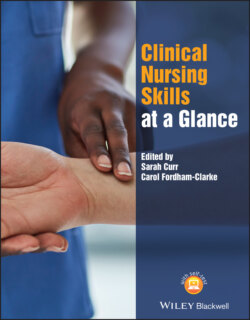Читать книгу Clinical Nursing Skills at a Glance - Группа авторов - Страница 3
List of Tables
Оглавление1 Chapter 3Table 3.1 Examples of paraphrasing.Table 3.2 Clarification questions.Table 3.3 SOLER – a tool to build rapport Identified by Egan (2014).
2 Chapter 5Table 5.1 Signs of aggression.
3 Chapter 8Table 8.1 Specific laws that relate to reportable activities.Table 8.2 Human rights articles relating to healthcare.Table 8.3 The six Ps of social media.
4 Chapter 9Table 9.1 Using TILEO for safety in manual handling.
5 Chapter 13Table 13.1 Personal protective equipment.
6 Chapter 15Table 15.1 Intramuscular injection sites.
7 Chapter 17Table 17.1 The ACVPU assessment tool.Table 17.2 Structured assessment of Glasgow Coma Scale (GCS).Table 17.3 The Glasgow Coma Scale (GCS) assessment tool.
8 Chapter 18Table 18.1 Pupil reactivity score.Table 18.2 Assessing limb strength.
9 Chapter 20Table 20.1 Assess the characteristics of pain using PQRST.Table 20.2 Pain assessment using SOCRATES.Table 20.3 PAINAD assessment tool.
10 Chapter 21Table 21.1 Escalation of findings.
11 Chapter 22Table 22.1 Management and diagnosis following first seizure.
12 Chapter 24Table 24.1 Sputum assessment.Table 24.2 Respiratory rates (RCP 2017).Table 24.3 Abnormal effort in breathing.Table 24.4 Abnormal patterns of breathing.
13 Chapter 26Table 26.1 Situations where arterial blood gases (ABGs) should be measured.Table 26.2 Arterial blood gas (ABG) interpretation.
14 Chapter 27Table 27.1 Normal breath sounds. Note that the pitch of sounds is dependent upon ...Table 27.2 Abnormal breath sounds.
15 Chapter 29Table 29.1 Safety considerations.
16 Chapter 31Table 31.1 Types of tracheostomy tube.
17 Chapter 32Table 32.1 Mechanisms of a chest drain.Table 32.2 Indications for chest drainageTable 32.3 Indications for clamping a chest drain.Table 32.4 Troubleshooting possible problems.
18 Chapter 33Table 33.1 Interpreting the pulse.Table 33.2 Assessing the quality of the pulse (pulse score).
19 Chapter 35Table 35.1 Thermoregulation.Table 35.2 Abnormal temperature states.
20 Chapter 38Table 38.1 Electrocardiogram (ECG) wave formation.
21 Chapter 40Table 40.1 Example of food chart.
22 Chapter 43Table 43.1 Classification of diarrhoea.Table 43.2 Nursing management of diarrhoea.
23 Chapter 44Table 44.1 Factors influencing constipation.Table 44.2 Pharmacological interventions to reduce constipation.
24 Chapter 46Table 46.1 Types of stoma.
25 Chapter 47Table 47.1 Significance of urinalysis results.
26 Chapter 48Table 48.1 Different types of incontinence.
27 Chapter 51Table 51.1 Urinary retention: signs and symptoms. *
28 Chapter 52Table 52.1 Timed Get Up and Go (TUG) test.
29 Chapter 53Table 53.1 Venous thromboembolism (VTE) risk assessment.Table 53.2 Risk factors for venous thromboembolism(VTE).
30 Chapter 54Table 54.1 Contraindications to anti‐embolic stockings (AES).Table 54.2 Anti‐embolic stockings (AES) – discharge information (NICE 2018)....
31 Chapter 55Table 55.1 The Enhanced Calgary‐Cambridge Model.
32 Chapter 56Table 56.1 Backward chaining.Table 56.2 Rolling a person on the floor to position handling equipment.Table 56.3 Managing a confined space fall.
33 Chapter 57Table 57.1 Checks for sensory and motor function as well as positional awareness ...
34 Chapter 60Table 60.1 Oral characteristics – healthy and unhealthy.Table 60.2 Common oral disorders.
35 Chapter 61Table 61.1 International National Pressure Ulcer Advisory Panel/European Pressure...Table 61.2 Interventions to prevent pressure ulcers.
36 Chapter 62Table 62.1 Assessment of the ulcer.Table 62.2 Venous ulcer assessment.Table 62.3 Physical characteristics of venous ulceration.
37 Chapter 64Table 64.1 Burn types and characteristics.Table 64.2 A–E assessment in burns injuries.
38 Chapter 65Table 65.1 Causes of death to be reported to Coroner.
39 Chapter 66Table 66.1 Types of surgical drain.
40 Chapter 68Table 68.1 Signs of hypoglycaemia and hyperglycaemia.Table 68.2 Accuracy of capillary blood glucose.
41 Chapter 69Table 69.1 Order of the draw.
42 Chapter 71Table 71.1 Intravenous fluid therapy – 5 Rs.
43 Chapter 72Table 72.1 Average fluid intake and output volume.
44 Chapter 73Table 73.1 Blood types.Table 73.2 Signs of allergic reaction.Table 73.3 Signs of adverse haemolytic reaction.Table 73.4 Signs of transfusion‐associated circulatory overload.
